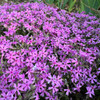Phlox subulata ssp. brittonii - MOSS PHLOX SUBSPECIES BRITTONII (botanical form)
Creeping phlox for those who want to stick with the wild forms of natives.
We propagate this one from cuttings, so our plants are uniform. But this moss phlox with darker magenta-pink flowers sets up quite a lot of seeds, so some seedlings with other colors may appear in your garden.
Blooming Time: usually for a couple weeks in April/May
Size: 4-6” tall x 16-18” wide, in time can form larger patch
USDA Zones: 3 to 9
Culture: full sun, half shade, dappled sun, organic, gravelly, rocky, sandy soils, poor and shallow soils, xeriscape. Adaptable plant, but drainage is essential!
Moisture Needs: dry, medium-dry, soil has to be drained
Origin: native wildflower to MD, OH, PA, VA and WV. Often found on shale slopes and close to rivers. In nature, it can have purple, pink or white flowers. This is a subspecies of Phlox subulata, which has much wider natural distribution - see the BONAP distribution map.
Deer/Rabbit Resistant: yes / yes
Attracts Butterflies or Pollinators: many insect are not active during its flowering season, but can attract butterflies and various bees
Attracts Hummingbirds: no
Pot Size: square 3.5" perennial x 4" deep perennial pot (1.22 pt/580 ml)
Picture Copyright: US Perennials
Plant Combinations: For the edges, along patios and paths, rock gardens, trough gardens, crevice gardens, slopes. Best combined with smaller to medium sized perennial – from native choose shorter Agastache, Anemone patens, Antennaria, Asclepias tuberosa, dwarf Baptisia, Campanula rotundifolia, Coreopsis, Cunila origanoides, Dalea, shorter Echinacea, Gaillardia, Gaura (shorter cultivars), smaller cultivars of Heuchera (in cooler regions), Penstemons, Ruellia humilis, shorter cultivars of Stokesia, Verbena canadensis, native grasses like Boutelloa gracilis, Koeleria cristata, Sporobolus heterolepis 'Tara' (or non-native Sesleria).
And non-native perennials like Achillea, summer blooming Allium, shorter Aquilegia, Armeria, Calamintha, Campanula, Cerastium, Delosperma, Dianthus, Geranium (G. sanquineum, G. dalmaticum and x cantabrigiense, G. cinereum, G. endresii, G. renardii), Gypsohila, Iris (dwarf and miniature bearded Iris), shorter Lavandula, shorter Nepeta, Origanum, shorter Platycodon, Satureja, Salvia, Sedum, Sempervivum, low Stachys,Scabiosa columbaria, Thymus, lower Veronica and many spring bulbs.

Phlox subulata ssp. brittonii - MOSS PHLOX SUBSPECIES BRITTONII (botanical form)
Creeping phlox for those who want to stick with the wild forms of natives.
We propagate this one from cuttings, so our plants are uniform. But this moss phlox with darker magenta-pink flowers sets up quite a lot of seeds, so some seedlings with other colors may appear in your garden.
Blooming Time: usually for a couple weeks in April/May
Size: 4-6” tall x 16-18” wide, in time can form larger patch
USDA Zones: 3 to 9
Culture: full sun, half shade, dappled sun, organic, gravelly, rocky, sandy soils, poor and shallow soils, xeriscape. Adaptable plant, but drainage is essential!
Moisture Needs: dry, medium-dry, soil has to be drained
Origin: native wildflower to MD, OH, PA, VA and WV. Often found on shale slopes and close to rivers. In nature, it can have purple, pink or white flowers. This is a subspecies of Phlox subulata, which has much wider natural distribution - see the BONAP distribution map.
Deer/Rabbit Resistant: yes / yes
Attracts Butterflies or Pollinators: many insect are not active during its flowering season, but can attract butterflies and various bees
Attracts Hummingbirds: no
Pot Size: square 3.5" perennial x 4" deep perennial pot (1.22 pt/580 ml)
Picture Copyright: US Perennials
Plant Combinations: For the edges, along patios and paths, rock gardens, trough gardens, crevice gardens, slopes. Best combined with smaller to medium sized perennial – from native choose shorter Agastache, Anemone patens, Antennaria, Asclepias tuberosa, dwarf Baptisia, Campanula rotundifolia, Coreopsis, Cunila origanoides, Dalea, shorter Echinacea, Gaillardia, Gaura (shorter cultivars), smaller cultivars of Heuchera (in cooler regions), Penstemons, Ruellia humilis, shorter cultivars of Stokesia, Verbena canadensis, native grasses like Boutelloa gracilis, Koeleria cristata, Sporobolus heterolepis 'Tara' (or non-native Sesleria).
And non-native perennials like Achillea, summer blooming Allium, shorter Aquilegia, Armeria, Calamintha, Campanula, Cerastium, Delosperma, Dianthus, Geranium (G. sanquineum, G. dalmaticum and x cantabrigiense, G. cinereum, G. endresii, G. renardii), Gypsohila, Iris (dwarf and miniature bearded Iris), shorter Lavandula, shorter Nepeta, Origanum, shorter Platycodon, Satureja, Salvia, Sedum, Sempervivum, low Stachys,Scabiosa columbaria, Thymus, lower Veronica and many spring bulbs.




